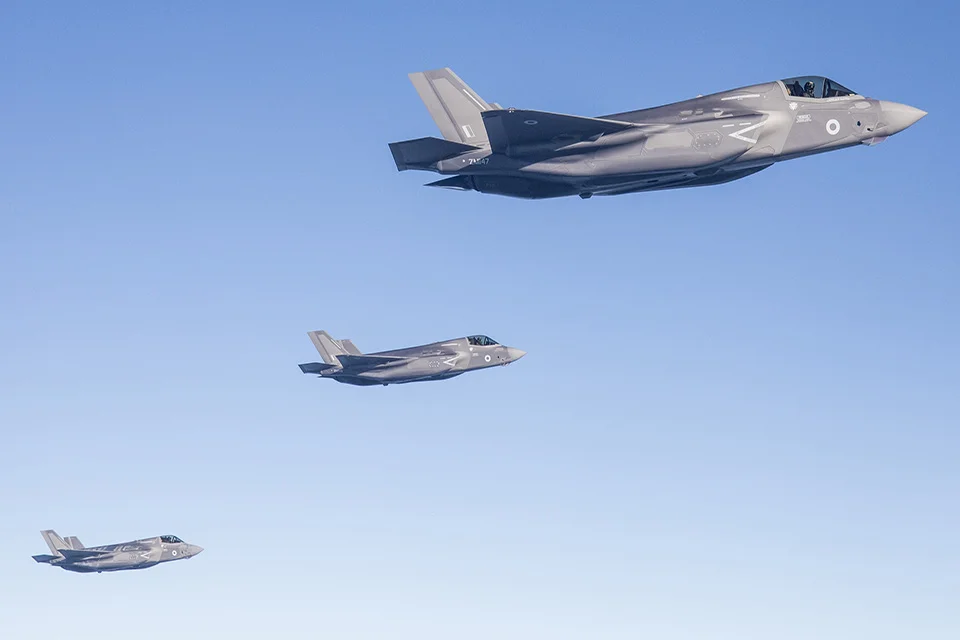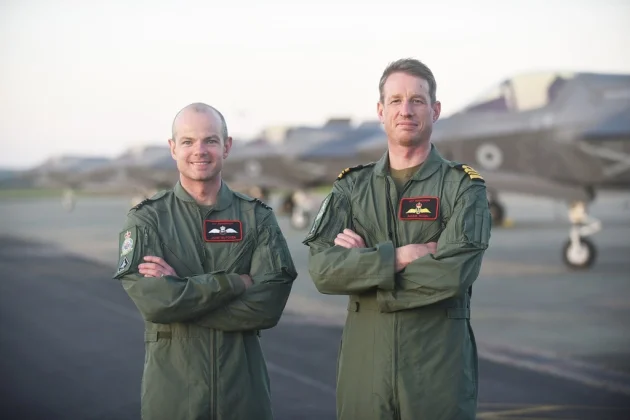The importance of the arrival of the F-35s within the overall context of UK defense transformation was highlighted by a UK Ministry of Defence article published on the day of the arrival of the jets at RAF Marham,
The first of Britain’s next-generation fighter jets have arrived home two months ahead of schedule in a major milestone for the Royal Air Force and Royal Navy.
The first four of Britain’s new cutting-edge aircraft arrived into RAF Marham their new home in Norfolk. They touched down at 20.15 after a trans-Atlantic flight from the United States, where Britain has more of the jets and 150 personnel in training.
The F-35s took off from Marine Corps Air Station Beaufort earlier today and were flown by British pilots of the newly-reformed 617 Squadron, which was immortalised by the famous Dambusters’ raid of World War II.
Welcoming the news, Defence Secretary Gavin Williamson said:
“These formidable fighters are a national statement of our intent to protect ourselves and our allies from intensifying threats across the world. With a game-changing ability to collect crucial intelligence, fight wars and tackle terrorism, these are the most advanced jets in British history.
“The work that’s gone into their early arrival shows they have the people to match. Our defence industry and military have always been at the very forefront of technology, and today’s momentous arrival of these incredible jets shows we are upholding our proud tradition of innovation while keeping Britain safe from the gravest of dangers.”
Defence Minister Guto Bebb said:
“The F-35 will form the backbone of our air power for decades to come, and its arrival in the UK during the 100th anniversary of the RAF marks a truly historic moment.
“In the face of growing threats, these fighter jets demonstrate our commitment to provide our Armed Forces with the cutting-edge technology they need to keep our people safe at home and abroad.”
The F-35s’ arrival in the UK two months ahead of schedule provides an opportunity for support staff to get a head-start in getting the aircraft ready for operational service at the end of this year.
Around £550m has been invested in RAF Marham as part of a major change programme to get the base ready to house the new jets. The base has seen an upgrade in facilities, resurfaced runways and the addition of new landing pads to accommodate the jet’s ability to land vertically.
Chief of the Air Staff Air Chief Marshal Sir Stephen Hillier said:
“In the RAF’s centenary year, it’s great to see the most advanced and dynamic fighter jet in our history arrive today at RAF Marham – and with the modern Dambusters in the cockpit, this homecoming truly feels like an historic moment in British airpower.
“If you can’t see us coming, you won’t be able to stop us, so with its stealth and other world-beating technologies the F35 Lightning takes the Royal Air Force and Royal Navy to a whole a new level of capability.”
This autumn, the first landing of the F-35 will take place on HMS Queen Elizabeth in the next phase of trials. Having both ship and aircraft operating together for the first time will be another significant moment for the Armed Forces.

The First Sea Lord, Admiral Sir Philip Jones said:
“Ever since aircraft first operated to and from ships, the Royal Navy has been at the forefront of maritime aviation and the arrival of our first F35Bs in the UK today, flown by both RAF and Fleet Air Arm pilots, is another important milestone on the way to restoring our place as leaders in the field of aircraft carrier operations.
“Once combined with our new aircraft carriers, HMS Queen Elizabeth and her sister ship HMS Prince of Wales, these extraordinary jets will sit at the heart of our country’s globally deployable expeditionary forces and provide the potent conventional deterrent we need to ensure our national security.”
The Lightning, as the aircraft will be known in the UK, is the first to combine radar-evading stealth technology with supersonic speeds and the ability to conduct short take-offs and vertical landings. It will be jointly operated by the Royal Air Force and the Royal Navy and can operate from land and sea, forming a vital part of ‘carrier strike’, the use of the aircraft from Britain’s new Queen Elizabeth Class aircraft carriers.
This is the first tranche of F-35s to arrive, with RAF Voyager aircraft providing air-to-air refuels on their trans-Atlantic journey. More jets are due in Britain later this year, and there is an overall plan to procure 138.
The F-35 is the world’s largest defence programme at over $1.3 trillion, and UK industry is providing 15% of every one of over 3,000 jets set for the global order book. That makes the economic impact greater than if we were building 100% of all 138 aircraft which we intend to buy.
The programme has already generated $12.9Bn worth of orders and at peak production will support thousands of British manufacturing and engineering jobs. Just last week, the F-35 programme awarded a contract worth over $2bn for aircraft propulsion systems, which will have significant benefits for Rolls-Royce and their supply chain.
A local UK newspaper, the Eastern Daily Press provided a look at the arrival of the aircraft in a story published on June 7, 2018.
The world’s most advanced warplane has touched down at RAF Marham – safeguarding thousands of jobs and making a vital contribution to our region’s economy.
Hundreds lined the lanes as the first four F-35 Lightnings roared in from America, securing the future of the West Norfolk base for another generation.
Station Commander Group Capt Ian “Cab” Townsend said: “This is a really remarkable day, not just for the Royal Air Force but for the local community. “We are so well supported by the local community, we couldn’t do what we do at the station without the tremendous support of the local people.
“I think what we have here is unique, they’ll be here for the next 35, 40 years. When the local community look up at the sky they will see the future.”
He said the arrival of Britain’s newest warplane was important for the local economy, adding: “A lot of people work in Marham so it’s really important for jobs.”
He said 15pc of the jets are made by British companies, adding: “It means a lot for the UK defence industries involved.
“As someone who has flown the F-35, it has been a real pleasure and a really good insight into what The pilots, whether from the land or the sea, are going to have an absolute ball.”
A further five jets will join the aircraft at Marham by August, with the recently reformed 617 Squadron, the famed Dambusters of the Second World War, set to declare initial operational capability from land by the end of December.
Air Commodore David Bradshaw, Lightning Force Commander, said: “We are at the start of a very long journey.
“Nine will grow over time to 12 and when we get a suitable size 617 will effectively be a super squadron.
“By the end of 2023 we will be at our full strength.”
Flt Lt Steve Clarkson, junior engineering officer for 617 Squadron, said: “I think it’s a really exciting time for everyone and the squadron itself.
“It’s a real honour especially with 617 Squadron given its history, we are going to be leading the way essentially.”
The so-called stealth fighter will replace the Tornado GR4, which has been in continual service for three decades.
When officials announced the Tornado’s retirement in 2010, there was uncertainty over where its replacement would be based.
There were not only more than 5,000 jobs at stake. The station brings tens of millions to our region’s economy.
So this newspaper, MPs and local politicians launched a campaign to make it Marham.
Almost 37,000 people from Norfolk, Suffolk and Cambridgeshire signed a petition launched in November 2010.
A delegation delivered it to 10 Downing Street, as MPs and council leaders put the case to save Marham to then Defence secretary Liam Fox.
In March 2013, the then defence secretary Philip Hammond flew to Norfolk to announce the station was saved.
Five years later, the first F-35s have touched down at the home of the new Lightning Force.

South West Norfolk MP Elizabeth Truss, who was at the forefront of the campaign, said: “It is fantastic to see the F-35 arrive in Marham.
“I believe the campaigning by everyone from the EDP and local residents to businesses and politicians helped to secure the long term future of the base and as a result, RAF Marham will be home to the most sophisticated fighter jet in the world.
“We should all be very proud – the jobs, skills and value to the local economy, in excess of £100 million, is tremendous and I am absolutely delighted that the RAF are in South West Norfolk.”
West Norfolk mayor and former council leader Nick Daubney was one of the key figures of the Make it Marham campaign.
peaking ahead of the arrival of the supersonic aircraft, he said: “The campaign was about making sure Marham survived and since then it has become Europe’s major station.
“The role it’s going to play in military defence will be a major one, it has become an advanced military centre.
“With all the jobs and technology that goes with it, Marham is an absolutely vital station. The development is good for the region, for jobs and for trainees in the future.”

